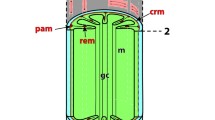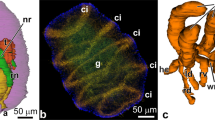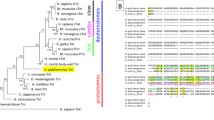Summary
Development of the esophageal muscles in embryonic sea urchins is described using light- and electron microscopy. The muscles develop from processes of about 14 cells of the coelomic epithelium that become immunore-active to anti-actin at about 60 h (12–14° C). Initially, eachmyoblast extends a single process with numerous fine filopodia around the esophagus. By 72 h the processes have reached the midline and fused with those from cells of the contralateral coelomic sac. Myoblasts begin to migrate out of the coelomic epithelium between 72 and 84 h. By 72 h the processes stain with the F-actin specific probe NBD-phallacidin. The contractile apparatus is not evident in transmission electron-microscopic preparations of embryos at 70 h, but by 84 h the contractile apparatus is present and the muscle cells are capable of contraction. Because the myoblasts migrate free of the coelomic epithelium and are situated on the blastocoelar side of the basal lamina, it is suggested that that they should be considered as a class of mesenchymal cells.
Similar content being viewed by others
References
Barak LS, Yokum RR, Nothnagel EA, Webb WW (1980) Fluorescence staining of the actin cytoskeleton in living cells with 7-nitrobenz-2-oxa-1,3-diazole-phallacidin. Proc Nat Acad Sci USA 77:980–984
Burke RD (1981) Structure of the digestive tract of the pluteus larva of Dendraster excentricus (Echinodermata: Echinoidea). Zoomorphology 98:209–225
Burke RD (1985) Actin-mediated retraction of the larval epidermis during metamorphosis of the sand dollar, Dendraster excentricus. Cell Tissue Res 239:589–597
Cavey MJ (1982) Myogenic events in compound ascidian larvae. Am Zool 22:807–815
Chia FS (1977) Scanning electron microscopic observations of the mesenchyme cells in the larvae of the starfish Pisaster ochraceus. Acta Zool 58:45–51
Cox KH, Angerer LM, Lee JJ, Davidson EH, Angerer RC (1986) Cell lineage-specific programs of expression of multiple actin genes during sea urchin embryogenesis. J Mol Biol 188:159–172
Crawford BJ, Chia FS (1978) Coelomic pouch formation in the starfish Pisaster ochraceus (Echinodermata: Asteroidea). J Morphol 157:99–120
Davidson EH (1986) Gene activity in early development. Academic Press, Orlando
Gibson AW, Burke RD (1985) The origin of pigment cells in embryos of the sea urchin Strongylocentrotus purpuratus. Dev Biol 107:414–419
Gustafson T, Wolpert L (1967) Cellular movement and contact in sea urchin morphogenesis. Biol Rev 42:442–498
Gustafson T, Lundgren B, Treufeldt R (1972) Serotonin and contractile activity in the echinopluteus. Exp Cell Res 72:115–139
Harkey MA (1984) Determination and differentiation of micromeres in the sea urchin embryo. In: Jeffery WR, Raff RA (eds) Time, space and pattern in embryonic development. Alan R, Liss, New York, pp 131–155
Holtzer H (1970) Myogenesis. In: Schjeide OA, De Vellis J (eds) Cell differentiation. Van Nostrad Reinhold, New York, pp 84–102
Holtzer H, Weintraub H, Mayne R, Mochan B (1972) The cell cycle, cell lineages, and cell differentiation. In: Moscona AA, Monroy A (eds) Current topics in developmental biology, Vol. 7. Academic Press, New York, pp 254–268
Ishimodo-Takagi T, Chino I, Sato H (1984) Evidence for the involvement of muscle tropomyosin in the contractile elements of the coelom-esophagus complex in sea urchin embryos. Dev Biol 105:365–376
Morrill JB (1986) Scanning electron microscopy of embryos. In: Schroeder TE (ed) Methods in cell biology, Vol. 27, Echinoderms, Gametes and embryos. Academic press, Orlando, pp 263–294
Strathmann M (1968) Methods in development series. I. General procedures and Echinodermata-Echinoidea. Friday Harbor Laboratories, Friday Harbor, Washington
Author information
Authors and Affiliations
Rights and permissions
About this article
Cite this article
Burke, R.D., Alvarez, C.M. Development of the esophageal muscles in embryos of the sea urchin Strongylocentrotus purpuratus . Cell Tissue Res. 252, 411–417 (1988). https://doi.org/10.1007/BF00214384
Accepted:
Issue Date:
DOI: https://doi.org/10.1007/BF00214384




